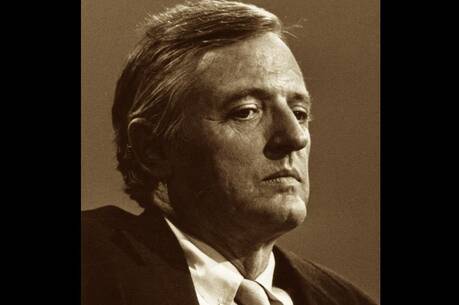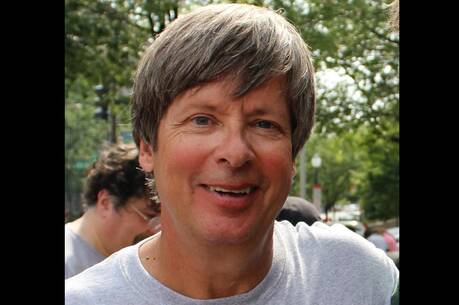The Spiritual Hedonist
The life of Caravaggio (1571-1610) is as starkly dramatic and riddled with violence as the paintings he made. Without the art, a film version would resemble Martin Scorsese’s “Mean Streets,” full of compulsive behavior and gang warfare. But drama and violence cannot account for Caravaggio’s artistic status in the Roman art world, where he was widely considered to be the best living painter in Italy. Nor can these account for his monumental reputation today.
According to Caravaggio’s biographer, Andrew Graham-Dixon, a British art critic, the artist’s handling of religious subject matter, in particular, continues to speak to us. His biography is especially compelling because he identifies Caravaggio’s religious vision as the distinguishing factor in the artist’s work. Graham-Dixon’s interpretations of specific paintings make up the best, most original parts of this tome.
Michelangelo Merisi, later called Caravaggio after his hometown, grew up in rural Lombardy. His father worked in nearby Milan. At 6, Michelangelo lost his father, grandparents and uncle to the bubonic plague, which left his mother struggling to support the family. At 13 he was apprenticed to an artist for several years, and at 21 he moved to Rome, where hundreds of other artists earned a livelihood decorating new and existing churches, including St. Peter’s Basilica, which was under construction. In this Counter-Reformation period religious art was used to woo the Catholic faithful, to catechize and inspire. Caravaggio, aware that Rome was Christianity’s pre-eminent pilgrimage site, liked to place his works inside the churches on the pilgrim route where they would be widely appreciated. He lodged in squalid artists’ quarter.
By day he painted fruit and flowers, angels and saints. By night he was a sword-wielding tough, involved in rumbles described in Roman court records. An early chapter describes an artist who arranged to have his mistress’s face slashed with a razor after he found her in bed with his brother. That artist was not Caravaggio, but Gianlorenzo Bernini, the sculptor who designed St. Peter’s Square and whose work adorns the interior of the Basilica. The author cites the slashing to stress that violent revenge was common; Caravaggio was not the only artist caught up in it.
As Caravaggio gained commissions, patrons and artistic maturity, one glimpses another side of Rome, reflected in the glistening palaces and dazzling art collections of cardinals and powerful dynasties like the Medici, the Borgias and the Colonnas. His link to this world was Constanza Colonna, a distant “family friend” whose wet nurse was the artist’s aunt. More than once Caravaggio sought her protection. His first patron was the kindly Cardinal del Monte, a father figure and mentor who arranged the artist’s first church commission.
In Italy Catholics ascribed to different schools of spirituality. By examining Caravag-gio’s paintings, Graham-Dixon shows that the artist embraced the teachings of the pauperist reformers, Carlo Borromeo and Filippo Neri, who welcomed the poor and saw the renunciation of worldly wealth as a way to imitate Christ. The painter was also influenced by the religious practices of Lombardy, which included re-enactments of religious scenes; he regarded his religious paintings as re-enactments, too, and positioned his models for theatrical effect.
Of Caravaggio’s painting “The Crucifixion of St. Peter,” Graham-Dixon writes, “It is a challenge as well as a call to conscience: viewers are brought into its space and invited to take the place of Peter’s executioners, at least in the mind’s eye—to make good their failings, to show compassion and mercy, to open up to the light of God.”
In “The Calling of St. Matthew,” Caravaggio seems to have considered how miracles take place, not with thunderclaps but in the barely discernible aspects of life. God, who is light, is subtly present in the painting. “The innkeeper cannot see it, but by standing where he does he casts a shadow on the wall that gives Christ a dark but unmistakable halo,” writes Graham-Dixon. He also attributes some of the artist’s subtleties to “a careful reading of the Bible.” The author presents Caravaggio as a master, able to grasp and convey on canvas profound spiritual truths.
Nevertheless, in a duel in 1606, Caravaggio killed a longtime enemy, Ranuccio Tomassoni. When their “seconds” entered the fray, the artist was injured. For this capital crime, he was exiled from Rome, condemned as a murderer and subject to a “capital sentence”—anyone in the papal states could kill him with impunity. For the rest of his life, the artist was on the run.
Caravaggio had often painted his likeness into his works. He smiles as “Bacchus,” peers out as one of “The Musicians,” closes his eyes as “St. Francis of Assisi in Ecstasy” and witnesses “The Martyrdom of St. Matthew.” After the murder of Tomassoni, however, he paints his face on the severed head of the giant in “David with the Head of Goliath.” “He is like one of the damned souls glimpsed by Dante in the Inferno, an outcast moaning forever in torment,” writes Graham-Dixon.
The final chapter of Caravaggio’s life contains its apex and its nadir. He paints his way into membership in the Knights of Malta, a strict religious order of soldiers. But his role in injuring a fellow knight quickly sends him to prison. After he escapes, an old enemy exacts revenge, slashing him in the face. Caravaggio never fully recovers. He dies on his way back to Rome, trying to rescue three paintings. He was 38.
Could anyone so angry, compulsive and unable to form lasting relationships have had the depth of religious understanding this biographer ascribes to Caravaggio? I am skeptical, but am almost persuaded by this passionately argued case.
This article also appeared in print, under the headline “The Spiritual Hedonist,” in the February 20, 2012, issue.








